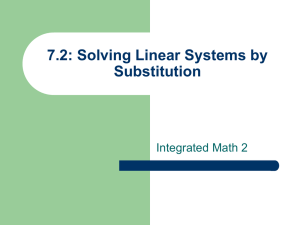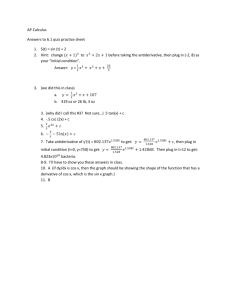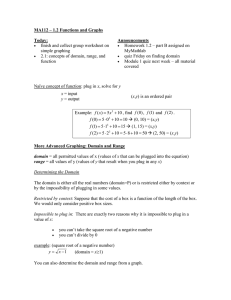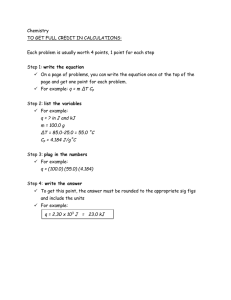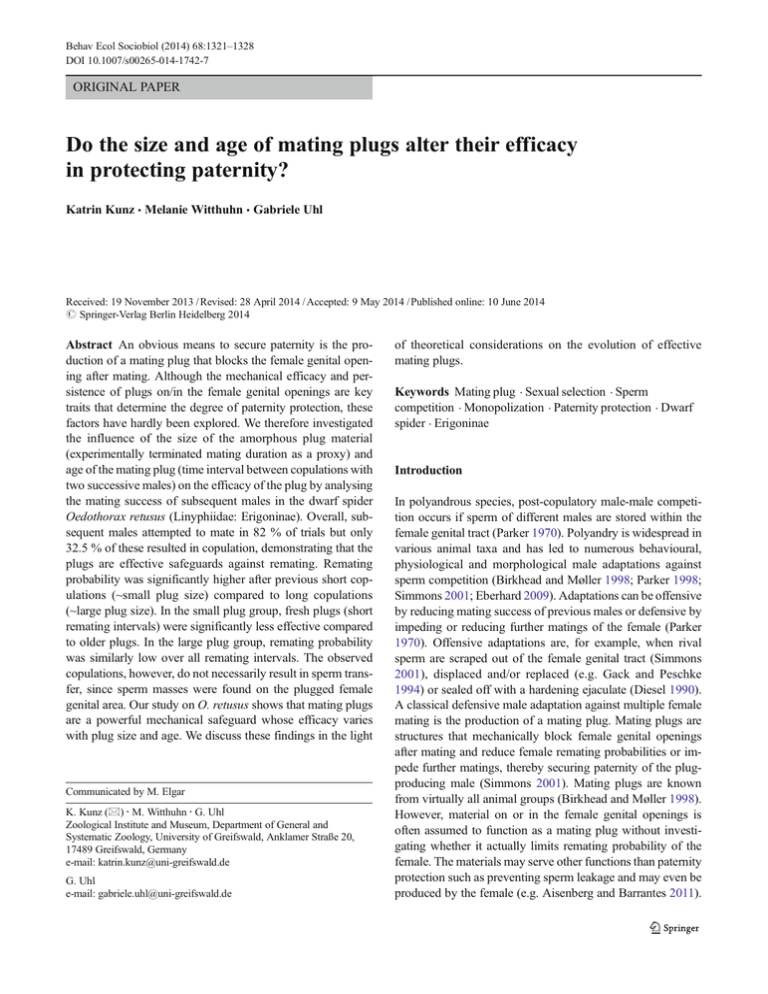
Behav Ecol Sociobiol (2014) 68:1321–1328
DOI 10.1007/s00265-014-1742-7
ORIGINAL PAPER
Do the size and age of mating plugs alter their efficacy
in protecting paternity?
Katrin Kunz & Melanie Witthuhn & Gabriele Uhl
Received: 19 November 2013 / Revised: 28 April 2014 / Accepted: 9 May 2014 / Published online: 10 June 2014
# Springer-Verlag Berlin Heidelberg 2014
Abstract An obvious means to secure paternity is the production of a mating plug that blocks the female genital opening after mating. Although the mechanical efficacy and persistence of plugs on/in the female genital openings are key
traits that determine the degree of paternity protection, these
factors have hardly been explored. We therefore investigated
the influence of the size of the amorphous plug material
(experimentally terminated mating duration as a proxy) and
age of the mating plug (time interval between copulations with
two successive males) on the efficacy of the plug by analysing
the mating success of subsequent males in the dwarf spider
Oedothorax retusus (Linyphiidae: Erigoninae). Overall, subsequent males attempted to mate in 82 % of trials but only
32.5 % of these resulted in copulation, demonstrating that the
plugs are effective safeguards against remating. Remating
probability was significantly higher after previous short copulations (~small plug size) compared to long copulations
(~large plug size). In the small plug group, fresh plugs (short
remating intervals) were significantly less effective compared
to older plugs. In the large plug group, remating probability
was similarly low over all remating intervals. The observed
copulations, however, do not necessarily result in sperm transfer, since sperm masses were found on the plugged female
genital area. Our study on O. retusus shows that mating plugs
are a powerful mechanical safeguard whose efficacy varies
with plug size and age. We discuss these findings in the light
Communicated by M. Elgar
K. Kunz (*) : M. Witthuhn : G. Uhl
Zoological Institute and Museum, Department of General and
Systematic Zoology, University of Greifswald, Anklamer Straße 20,
17489 Greifswald, Germany
e-mail: katrin.kunz@uni-greifswald.de
G. Uhl
e-mail: gabriele.uhl@uni-greifswald.de
of theoretical considerations on the evolution of effective
mating plugs.
Keywords Mating plug . Sexual selection . Sperm
competition . Monopolization . Paternity protection . Dwarf
spider . Erigoninae
Introduction
In polyandrous species, post-copulatory male-male competition occurs if sperm of different males are stored within the
female genital tract (Parker 1970). Polyandry is widespread in
various animal taxa and has led to numerous behavioural,
physiological and morphological male adaptations against
sperm competition (Birkhead and Møller 1998; Parker 1998;
Simmons 2001; Eberhard 2009). Adaptations can be offensive
by reducing mating success of previous males or defensive by
impeding or reducing further matings of the female (Parker
1970). Offensive adaptations are, for example, when rival
sperm are scraped out of the female genital tract (Simmons
2001), displaced and/or replaced (e.g. Gack and Peschke
1994) or sealed off with a hardening ejaculate (Diesel 1990).
A classical defensive male adaptation against multiple female
mating is the production of a mating plug. Mating plugs are
structures that mechanically block female genital openings
after mating and reduce female remating probabilities or impede further matings, thereby securing paternity of the plugproducing male (Simmons 2001). Mating plugs are known
from virtually all animal groups (Birkhead and Møller 1998).
However, material on or in the female genital openings is
often assumed to function as a mating plug without investigating whether it actually limits remating probability of the
female. The materials may serve other functions than paternity
protection such as preventing sperm leakage and may even be
produced by the female (e.g. Aisenberg and Barrantes 2011).
1322
Moreover, even if the materials were demonstrated to serve as
paternity protection devices, the conditions and constraints
that shape their efficacy are still largely underexplored.
Supposed mating plugs were found in many spider families
(Austad 1984; Uhl et al. 2010). The genital morphology of
entelegyne spiders seems to promote the occurrence of mating
plugs since females possess three genital openings—two are
used for copulation and one for oviposition (Uhl et al. 2010).
This allows the male to obstruct the copulatory ducts without
impeding oviposition. Further, spiders possess a high potential
for sperm competition since females frequently mate with
several males, and sperm can be stored over long periods of
time in the female genital tract (Elgar 1998). Supposed mating
plugs in spiders consist primarily of amorphous material but
can also consist of parts of or complete male pedipalps, the
secondary copulatory organs (Uhl et al. 2010). Recently,
genital fragments were shown to be effective plugs in the
orb-weaver Argiope keyserlingi (Herberstein et al. 2012).
However, in many species, several male fragments can be
found in the female genital system, demonstrating that subsequent matings are possible (Uhl et al. 2010).
Here, we focus on amorphous materials on/in the female
genital opening since this type of potential mating plug is
particularly widespread in the animal kingdom including spiders (Uhl et al. 2010). When the material is transferred from
the male to the female, it must be transferred in a liquid state
and has to solidify to a certain degree if it is meant to withstand
penetration or removal by a rival male. We therefore hypothesize that plugs are not as effective immediately after their
placement compared to after curing. Since a plug only helps to
secure paternity if it remains functional until oviposition, the
degree of persistence of the material is a further crucial aspect
that determines paternity success. Furthermore, plug efficacy
may strongly depend on plug size if large amounts of material
are more difficult to remove compared to small amounts (e.g.
Masumoto 1993; Polak et al. 2001). In the butterfly Cressida
cressida, large mating plugs even present lifelong chastity
belts (Orr and Rutowski 1991).
In this study, we follow up on findings in the dwarf spider
Oedothorax retusus (Linyphiidae: Erigoninae) in which an
amorphous mass is found on the female copulatory opening
after mating (Uhl and Busch 2009). Mating plugs are significantly larger after longer matings which allows using copulation duration as a proxy for plug size (Uhl and Busch 2009).
When experimentally terminating matings after 1 or 3 min,
small mating plugs proved to be ineffective but large plugs
prevented remating of the female in 93 % of cases. In this
previous study, all remating trials were staged within 15 min.
However, in order to understand the full potential and limitations of mating plugs, we need to assess how plug size, plug
age and their interaction determine plug efficacy.
We hypothesize that mating plug efficacy in O. retusus
depends (i) on first mating duration (short, long) which can
Behav Ecol Sociobiol (2014) 68:1321–1328
be used as a proxy for plug size and (ii) on plug age taken as the
time interval between first copulation and the second mating
trial (15 min; 1 h; 1 day; 3 days after mating; after oviposition).
Since cleaning behaviour by the female may potentially alter
plug presence and size, we observed if females cleaned the
genital region during 1 h post-mating. When subsequent males
attempted or succeeded in remating, we investigated the condition of the mating plugs under the SEM. In order to test if
female receptivity and attractiveness to males may depend on
plug size and age, we further registered aggressive behaviour
by females towards males and male courtship probability.
Material and methods
Study species: O. retusus
The dwarf spider O. retusus belongs to the Erigoninae (Miller
and Hormiga 2004) which is the largest group within the
Linyphiidae. We used males and females that were raised in
the laboratory from egg sacs of females caught along the
banks of the river Rhine south of Bonn, Germany (50° 43′
00.26″ N, 7° 08′ 25.11″ E–50° 42′ 57.40″ N, 7° 08′ 36.70″ E).
Adult spiders were kept individually in 25 ml plastic containers equipped with a moist layer of gypsum at a temperature
of 23/17 °C (day/night) and 70 % humidity. They were fed
weekly with four to six fruit flies, Drosophila melanogaster.
Spiderlings were fed ad libitum on springtails, Sinella
curviseta, until the subadult stage (Kunz et al. 2012).
Courtship and copulation in O. retusus
Courtship in O. retusus starts with the male vibrating his
opisthosoma. As soon as the male achieves the contralateral
mating position, he stretches one of his pedipalps (secondary
copulatory organs) towards the external female genital structure (epigyne) and tries to insert into one of two female
copulatory openings. Copulation starts when the male successfully inserts a pedipalp into the corresponding female
copulatory opening and the hematodocha (membranous part
of the sperm transfer organ) inflates. The insertion mode is
ipsilateral, meaning that the right pedipalp is inserted into the
right female copulatory opening, which is typical for
entelegyne spiders (Huber and Senglet 1997). A mating plug
in O. retusus appears as a transparent mass shortly after
copulation that transforms into solid opaque material (Kunz
and Witthuhn, personal observations).
Influence of plug size and age on paternity protection
We investigated plug efficacy of O. retusus by staging
remating trials that varied in plug size as determined by first
male copulation durations (Uhl and Busch 2009) and plug age
Behav Ecol Sociobiol (2014) 68:1321–1328
as determined by latencies between first and second matings.
To make sure that both first and second males used the same of
the two female genital openings, one of the two pedipalps of
each male was amputated on the same side. As a consequence,
both males of a mating trial were restricted to using either the
right or the left pedipalp.
Courtship and mating behaviours of males and females
were observed as described in Kunz et al. (2012). The observation period started when the first male was placed in the
container of a virgin female and ended with copulation or after
1 h. Copulations were terminated by the experimenter after 1
or 3 min in order to create the two treatment groups with a
high probability of small (1 min) and large (3 min) mating
plugs (Uhl and Busch 2009). Undisturbed copulations with
one pedipalp last on average 3.21 min in O. retusus (Richter
2006). In the following, we use the terms “small plug group”
for those remating trials in which the female previously had
experienced a 1-min copulation and “large plug group” for
those trials in which the female had experienced a 3-min
copulation. Subsequent mating trials were staged after five
different intervals: 15 min, 1 h, 1 day, 3 days after mating, or
after the female had oviposited (same day or day after). These
intervals serve as categories for plug age. When copulations
occurred in remating trials, they were not terminated by the
experimenter. Second males were removed after copulation or
after 1 h of observation time. In 19.9 % of cases (38 out of
191), second males did not try to assume mating position and
were replaced by third males. In the following, second or third
males whose pedipalps were in contact with the female genital
area are treated as “second mating partners”. All males were
used for a single mating only.
Of all staged mating trials, 45.4 % (191 out of 421) were
used for the analysis (total N=99 for the 1-min group: 15 min
N=20; 1 h N=19; 1 day N=20; 3 days N=20; oviposition N=
20; and total N=92 for the 3-min group: 15 min N=19; 1 h N=
17; 1 day N=19; 3 days N=20; oviposition N=17). During
mating trials, we recorded aggressive behaviour of females
towards males (attacking and chasing away of the potential
mate, Kunz et al. 2012) to detect potential effects of plug size
and age on female receptivity. Further, females were observed
for 1 h after their first mating in order to detect potential
cleaning activity of the genital region that may influence the
presence and state of the mating plug. Females of short
remating intervals were observed for cleaning activity during
their second mating trial.
We controlled for male and female age calculated as days
elapsed from the final moult. Females of the small plug group
were on average 26.4±4.6 days, and those of the large plug
group were on average 25.9±3.5 days old (Mann-Whitney U
test: N=99, Z=−0.01, p=0.361). Males of the small plug
group were 26.4±4.5 days old, and males from the large plug
group 26.0±3.8 days old (Mann-Whitney U test: N=92, Z=
−0.89, p=0.376).
1323
Scanning electron microscopy
Female opisthosomata (N=143) of those trials in which
remating attempts or rematings occurred were fixed in
Dubosq-Brazil solution (Mulisch and Welsch 2010) in order
to investigate the condition of the mating plug. Seventy females
were investigated from the small plug group (15 min N=12; 1 h
N=14; 1 day N=18; 3 days N=14; oviposition N=12), and 73
females from the large plug group (15 min N=15; 1 h N=12;
1 day N=17; 3 days N=15; oviposition N=14). After a minimum of 2 days of infiltration, the samples were dehydrated in
an ascending ethanol series, chemically dehydrated with
1,1,1,3,3,3-hexamethyldisilazane (HMDS), sputter-coated for
200 s with gold/palladium (80/20) (Polaron SC7640, Fisons
Instruments) and investigated under a SEM EVO LS10 (Zeiss)
at the Imaging Centre of the University of Greifswald. We
inspected the female genitalia for presence, location (right/left
copulatory duct), size category (small/large) and whether spermatozoa were visible in the plug material.
Statistical analysis
Statistical analyses were performed using IBM SPSS Statistics
version 20. Normally distributed data are given as arithmetic
mean±standard deviation (mean±SD). Non-normally distributed data are given as median, interquartile range (IQR), and
are ln-transformed for GLM analysis. GLM analyses were
performed with the parameters “plug size” (1-min group and
3-min group), “plug age” (15 min, 1 h, 1 day, 3 days, oviposition) and “interaction between size and age” and are given as
Wald χ2 or likelihood ratio χ2 (LR χ2) in the case of transformed data. For binomial data, we used GLM with binomial
distribution and logit link function. None of the interactions
were significant (all p>0.178). We further explored significant
parameters from the GLM analysis using χ2 and MannWhitney U test.
Results
Mating plugs as a mechanical safeguard?
We analysed if mating plug efficacy depends on plug size
(1 and 3 min during first copulation) and/or plug age
(time interval between first and second copulation) by
investigating copulation attempts and remating success.
One hundred fifty-seven out of 191 (82.2 %) second
mating partners performed copulation attempts with their
single pedipalp on the plugged female copulatory opening. The probability of copulation attempts was not different between the plug size groups (GLM: copulation
attempts yes/no: small plug group, 78/21 (78.8 %); large
0.005
<0.001
0.235
0.024
<0.001
0.115
0.967
0.813
p
20
17
10
9
20
17
4
1
15/5 (75.0 %)
18/2 (90.0 %)
17, IQR 60
45.2±43.9
6/14 (30.0 %)
1/19 (5.0 %)
154.2±117.2
147.0±0.0
20
20
15
18
20
20
6
1
18/2 (90.0 %)
16/3 (84.2 %)
32, IQR 90
34.3±32.9
7/13 (35.0 %)
6/13 (31.6 %)
130.6±119.9
123.3±98.5
20
19
18
16
20
19
7
6
18/1 (94.7 %)
17/0 (100.0 %)
14, IQR 33
69.8±65.6
11/8 (57.9 %)
4/13 (23.5 %)
164.0±72.1
110.0±93.4
19
17
18
17
19
17
11
4
17/3 (85.0 %)
19/0 (100.0 %)
10, IQR 27
36.4±35.1
17/3 (85.0 %)
5/14 (26.3 %)
156.6±95.6
161.2±138.6
20
19
17
19
20
19
17
5
ANOVAs (F)
Kruskal-Wallis tests
b
a
Copulation duration [s]
Remating (yes/no)
Copulation attempts [no.]
Small
Large
Small
Large
Small
Large
Small
Large
Copulation attempts (yes/no)
N
N
N
N
N
10/10 (50.0 %)
9/8 (52.9 %)
11, IQR 20
12.2±12.1
4/16 (20.0 %)
1/16 (5.9 %)
165.3±126.8
17.0±0.0
14.95
21.44
5.55b
3.00a
21.84
7.43
0.14a
0.39a
Fa, χ2
Oviposition
Events
Mean/median
3 days
Events
Mean/median
1 day
Events
Mean/median
1h
Events
Mean/median
15 min
Events
Mean/median
Plug
plug group, 79/13 (85.9 %); Wald χ2 =0.00, df =1, p=
0.999) but significantly different between plug age classes
(copulation attempts yes/no: 15 min, 36/3 (92.3 %); 1 h,
35/1 (97.2 %); 1 day, 34/5 (87.2 %); 3 days, 33/7
(82.5 %); oviposition, 19/18 (51.4 %); Wald χ2 =13.72,
df=4, p=0.008). The lower probability of copulation attempts in the oviposition group accounted for this significant difference. When excluding the oviposition interval,
there was no significant effect between the remaining plug
age classes (Wald χ2 =0.19, df=3, p=0.980) (see Table 1
for data per size and age groups). The number of copulation attempts a male performed was marginally significantly different between plug size groups (GLM: number
of copulation attempts: small plug group (N=78) 16, IQR
41; large plug group (N=79) 24, IQR 57; LR χ2 =3.51,
df=1, p=0.061), whereas the number of copulation attempts differed significantly between plug age classes
(number of copulation attempts: 15 min (N=36) 17, IQR
42; 1 h (N=35) 24, IQR 85; 1 day (N=34) 24, IQR 49;
3 days (N=33) 24, IQR 65; oviposition (N=19) 6, IQR
19; LR χ2 =12.27, df=4, p=0.015). The significant effect
can be attributed to the low number of copulation attempts
in the oviposition group. When removed from the analysis, the number of copulation attempts was not significantly different between plug age classes (LR χ2 =4.09,
df=3, p=0.252) (see Table 1 for data per size and age
groups).
Altogether 32.5 % of males (62 out of 191) copulated with
a mated female. The overall probability of remating was
significantly higher for the small plug group (GLM: remating
yes/no: small plug group, 45/54 (45.5 %); large plug group.
17/75 (18.5 %); Wald χ2 =14.39, df=1, p<0.001). Likewise,
plug age classes overall revealed significantly different female
remating probabilities (remating yes/no: 15 min, 22/17
(56.4 %); 1 h, 15/21 (41.7 %); 1 day, 13/26 (33.3 %); 3 days,
7/33 (17.5 %); oviposition, 5/32 (13.5 %); Wald χ2 =17.17,
df=4, p=0.002). In the small plug group, plug age class had a
highly significant effect on remating probabilities (Table 1;
Fig. 1, light grey bars). Only the 15-min age class accounted
for the significant effect since the other age classes (1 h to after
oviposition) did not differ significantly when compared without the 15-min age class (χ2 =6.53, df=3, p=0.088). Differences between plug size groups remained significant after
excluding the 15-min interval from the analysis (GLM:
remating yes/no: small plug group, 28/51 (35.4 %); large plug
group, 12/61 (16.4 %); Wald χ2 =7.18, df=1, p=0.007). In the
large plug group, overall remating probabilities were low and
not significantly different between plug age classes (Table 1;
Fig. 1, dark grey bars).
The copulation duration of subsequent males was not significantly different between the plug size groups (GLM: copulation duration in seconds: small plug group (N=45), 154.8±
96.2; large plug group (N=17), 126.5±103.4; Wald χ2 =1.52,
Behav Ecol Sociobiol (2014) 68:1321–1328
Table 1 Courtship and mating parameters of Oedothorax retusus in mating trials with females bearing small plugs or large plugs. Data are given for five plug age classes (intervals between first and second
copulation: 15 min, 1 h, 1 day, 3 days, after oviposition). Data are given as events (proportions), mean ± standard deviation, and median, interquartile range (IQR). Statistical analysis was performed using
χ2 test, ANOVAs (F) and Kruskal-Wallis tests. Significant p-values are shown in bold. Overall GLM results for the parameters plug size and plug age plus interaction are given in the text
1324
Behav Ecol Sociobiol (2014) 68:1321–1328
1325
Fig. 1 Percentages of copulations (full bars) and unsuccessful copulation
attempts (striped bars) in Oedothorax retusus mating trials with mated
females that bear small (light grey bars) or large mating plugs (dark grey
bars). Data are given for five plug age classes (interval between first
mating and second mating trial: 15 min, 1 h, 1 day, 3 days, after
oviposition). Asterisks mark significant differences in pairwise χ2 tests
after sequential Bonferroni correction (**0.001≤α≤0.01, ***α<0.001)
df=1, p=0.218) nor between plug age classes (15 min (N=
22), 157.6±103.1; 1 h (N=15), 149.6±78.7; 1 day (N=13),
127.2±106.1; 3 days (N=7), 153.1±107.0; oviposition (N=
5), 135.6±128.3; Wald χ2 =1.78, df=4, p=0.777) (see Table 1
for data per size groups and age classes).
State of the mating plug after remating
Fig. 2 SEM photographs of the
genital regions of mated
Oedothorax retusus females. a
Small mating plug (arrowhead) in
the right side of the female genital
opening typical for the 1-min
group (once mated female). b
Large mating plug (arrowhead) in
the left side of the female genital
opening typical for the 3-min
group (once mated female). c
Large, inhomogeneous mating
plug (once mated female). d
Damaged mating plug (second
male performed 67 copulation
attempts). e Large, loopy,
homogenous mating plug (once
mated female). f Plane, previously
loopy (arrowhead) mating plug
including spermatozoa from a
subsequent mating. g
Spermatozoa (~3 μm, red circles)
and amorphous secretion
(arrowhead) after remating. Scale
bars: a–f=20 μm, g=2 μm
In those cases in which remating occurred, the plug material
contained spermatozoa (Fig. 2) with significantly higher probability than in cases in which only copulation attempts were
1326
observed (sperm yes/no: successful remating, 27/11 (71.1 %);
unsuccessful remating, 14/91 (13.3 %); χ2 =45.45, df=1,
p<0.001). This result holds for the small plug group where
most rematings occurred (sperm yes/no: successful remating,
21/8 (72.4 %); unsuccessful remating, 3/38 (7.3 %); Fisher’s
exact test: p<0.001) as well as for the large plug group (sperm
yes/no: successful remating, 6/3 (66.7 %); unsuccessful
remating, 11/53 (17.2 %); Fisher’s exact test: p=0.004).
The SEM analysis of the state of the mating plug after
remating revealed that 58 % of mating plugs show areas of
broken off plug material (sharp edges) (Fig. 2d) that were not
observed in previous investigations on once mated females
(Uhl and Busch 2009).
Potential influence of plug size and age on female
attractiveness and receptivity
To assess the potential effects of size and age of the mating
plug on female attractiveness, we analysed courtship behaviour of second mating partners. Courtship probabilities of
second males were not different between plug size groups
(GLM: courtship yes/no: small plug group, 97/2; large plug
group, 92/0; Wald χ2 =0.00, df=1, p=0.999). There was also
no difference in courtship probability between plug age classes (courtship yes/no: 15 min, 39/0; 1 h, 36/0; 1 day, 39/0;
3 days, 39/1; oviposition, 36/1; Wald χ2 =0.00, df=4, p=
1.000). Courtship latency of second males was also not significantly different between the plug size groups (GLM: courtship latency in seconds: small plug group (N=97) 124.4±
316.6; large plug group (N=92) 147.6±385.1; Wald χ2 =
0.20, df=1, p=0.653) nor between plug age classes (15 min
(N=39), 115.1±202.7; 1 h (N=36), 120.6±234.8; 1 day (N=
39), 159.4±433.1; 3 days (N=39), 216.7±543.6; oviposition
(N=36), 59.8±149.3; Wald χ2 =4.22, df=4, p=0.377). Likewise, the time it took to achieve mating position was not
significantly different between the plug size groups (GLM:
latency mating position: small plug group (N=83) 254, IQR
443; large plug group (N=81) 273, IQR 725; LR χ2 =0.72,
df=1, p=0.398) nor between plug age classes (latency mating
position: 15 min (N=39) 302, IQR 746; 1 h (N=36) 239, IQR
537; 1 day (N=36) 220, IQR 352; 3 days (N=33) 274, IQR
505; oviposition (N=20) 399, IQR 1,087; LR χ2 =5.51, df=4,
p=0.239).
We further analysed aggressive behaviour of females
towards second mating partners in order to assess the
potential effects of mating plug size and age on female
receptivity. The probability of female aggressiveness was
not significantly different in remating trials between plug
size groups (GLM: female aggressiveness yes/no: small
plug group, 24/75 (24.3 %); large plug group, 14/78
(15.2 %); Wald χ2 =1.48, df=1, p=0.224) nor between plug
age classes (female aggressiveness yes/no: 15 min, 3/36
(7.7 %); 1 h, 4/32 (11.1 %); 1 day, 10/29 (25.6 %); 3 days,
Behav Ecol Sociobiol (2014) 68:1321–1328
8/32 (20.0 %); oviposition, 13/24 (35.1 %); Wald χ2 =8.16,
df=4, p=0.086). The number of aggressive interactions was
not significantly affected by plug size (GLM: number of
aggressive interactions: small plug group (N=24) 1, IQR 2;
large plug group (N=14) 1, IQR 2; LR χ2 =0.31, df=1, p=
0.579) nor by plug age (number of aggressive interactions:
15 min (N=3) 0, IQR 0; 1 h (N=4) 3, IQR 5; 1 day (N=
10) 1, IQR 0; 3 days (N=8) 1, IQR 1; oviposition (N=13)
2, IQR 4; LR χ2 =6.94, df=1, p=0.139).
Can female cleaning behaviour affect plug presence and size?
Female post-copulatory cleaning behaviour may influence
plug presence and size. Cleaning after copulation occured in
6.3 % of females (12 out of 191). Our experimental plug size
groups did not significantly differ in cleaning probability
(cleaning yes/no: small plug group, 6/93 (6.1 %); large plug
group. 6/86 (6.5 %); χ2 =0.02, df=1, p=0.896). Due to the
rare occurrence of cleaning behaviour, plug age classes were
not analysed.
Discussion
Polyandrous mating combined with long-term sperm storage
is particularly widespread in insects and spiders (Elgar 1998;
Simmons and Siva-Jothy 1998), and mechanical safeguards
against polyandrous mating are suspected to have evolved
many times independently. The mating plug in O. retusus
clearly functions as a mechanical obstacle to rival males.
Overall, small plugs are less effective than large plugs. Shortly
after plug placement, small plugs are least effective suggesting
that size and hardening of the material plays an important role.
Once plugs are older than a day, they strongly serve to monopolize access to the duct that leads to the female sperm
storage organ. However, even if subsequent males are able to
mate, at least part of their sperm mass remains outside of the
female genital tract, which considerably adds to the efficacy of
the mating plug. Consequently, if a male succeeds in plugging
both of the females’ copulatory openings, his paternity success is expected to be very high.
There is increasing evidence that mating plugs can be
produced by the female (Aisenberg and Eberhard 2009;
Aisenberg and Barrantes 2011; Kuntner et al. 2012), demonstrating that detailed analysis of the origin of the substance is a basic requirement to understand the adaptive
context in which the plug evolved. In our model species
O. retusus, the mating plug is produced inside of the male
copulatory organs, the pedipalps (Uhl et al. 2014) and there
is no indication that females participate in plug production
or can remove the plug after mating. As shown here, the
efficacy of the mating plug is strongly shaped by plug size,
Behav Ecol Sociobiol (2014) 68:1321–1328
with efficacy greater in large plugs. This suggests that smaller
portions of plug material can be more easily removed or
overcome by a subsequent male as was also shown for some
insects and spiders (Jackson 1980; Matsumoto and Suzuki
1992; Masumoto 1993). Plug age can also determine plug
efficacy, although this effect occurred only for small plugs,
which became more effective as they aged, suggesting that
hardening of the material is required (see also Matsumoto and
Suzuki 1992).
It is not clear whether males that copulated with mated
females were able to transfer sperm, since sperm were found
on the genital area, suggesting that the paternity protection
afforded by mating plugs is even greater than that suggested
by remating probabilities. Instead of operating as a physical
barrier, mating plugs may alter female behaviour and receptivity (Eberhard 2004; Colonello and Hartfelder 2005; Wedell
2005; Avila et al. 2011) or reduce female attractiveness for
subsequent males (Parker 1970; Shine et al. 2000; O’Donnell
et al. 2004). In O. retusus, we cannot disentangle potential
effects of mating from those of the mating plug itself, since
mating results in a visible plug in 98 % of cases (Uhl and
Busch 2009). However, the level of female receptivity did not
depend on plug size and age. Only after oviposition, female
aggressiveness towards the male was increased, possibly due
to a short phase of brood care (Kunz, personal observation).
Transfer of antiaphrodisiac pheromones that reduce female
attractiveness has been reported for example for beetles and
butterflies (Andersson et al. 2003; Schulz et al. 2008;
Schlechter-Helas et al. 2011). There were no significant differences in courtship probabilities and latencies of second
O. retusus males between plug size and age treatments. Thus,
we consider it unlikely that plugs contain antiaphrodisiac.
When considering the evolution of mating plugs, the particular morphology of the genitalia system plays a largely
neglected but important role. In species with one female
genital opening, a mating plug needs to decay before oviposition, whereas in animal groups with separate copulatory and
oviposition ducts, such as most Lepidoptera and Araneae,
long-lasting plugs applied to the copulatory ducts may easily
evolve. However, spiders are special since most species exhibit two copulatory ducts in the female genital tract (Uhl et al.
2010). Females may allow one or two insertions by a particular male thereby allowing him to plug one or two ducts. This
important morphological component and the resulting possibilities for female mate choice require being included into
models on the evolution of mating plugs (e.g. Fromhage
2011).
Acknowledgments We thank Rabea Schlüter (Imaging Centre University of Greifswald) for expert introduction to the SEM microscope. We
thank Lara Lopardo, Michael Schmitt, the editor Mark Elgar and three
anonymous reviewers for their constructive comments, which helped us
to improve the manuscript. The experiments comply with the current laws
of Germany.
1327
Conflict of interest The authors declare that there is no conflict of
interest.
References
Aisenberg A, Barrantes G (2011) Sexual behavior, cannibalism, and
mating plugs as sticky traps in the orb weaver spider Leucauge
argyra (Tetragnathidae). Naturwissenschaften 98:605–613
Aisenberg A, Eberhard WG (2009) Female cooperation in plug formation
in a spider: effects of male copulatory courtship. Behav Ecol 20:
1236–1241
Andersson J, Borg-Karlson AK, Wiklund C (2003) Antiaphrodisiacs in
pierid butterflies: a theme with variation! J Chem Ecol 29:1489–
1499
Austad SN (1984) Evolution of sperm priority patterns in spiders. In:
Smith RL (ed) Sperm competition and the evolution of mating
systems. Academic Press, San Diego, pp 223–249
Avila FW, Sirot LK, LaFlamme BA, Rubinstein CD, Wolfner MF (2011)
Insect seminal fluid proteins: identification and function. Annu Rev
Entomol 56:21–40
Birkhead TR, Møller AP (1998) Sperm competition and sexual selection.
Academic Press, London
Colonello NA, Hartfelder K (2005) She’s my girl—male accessory gland
products and their function in the reproductive biology of social
bees. Apidologie 36:231–233
Diesel R (1990) Sperm competition and reproductive success in the
decapod Inachus phalangium (Majidae): a male ghost spider crab
that seals off rivals’ sperm. J Zool 220:213–223
Eberhard WG (2004) Why study spider sex: special traits of spiders
facilitate studies of sperm competition and cryptic female choice. J
Arachnol 32:545–556
Eberhard WG (2009) Postcopulatory sexual selection: Darwin’s omission
and its consequences. Proc Natl Acad Sci 106:10025–10032
Elgar MA (1998) Sperm competition and sexual selection in spiders and
other arachnids. In: Birkhead TR, Møller AP (eds) Sperm competition and sexual selection. Academic Press, London, pp 307–339
Fromhage L (2011) Mating unplugged: a model for the evolution of
mating plug (dis-)placement. Evolution 66–1:31–39
Gack C, Peschke K (1994) Spermathecal morphology, sperm transfer and
a novel mechanism of sperm displacement in the rove beetle,
Aleochara curtula (Coleoptera, Staphylinidae). Zoomorphology
114:227–237
Herberstein ME, Wignall AE, Nessler SH, Harmer AMT, Schneider JM
(2012) How effective and persistent are fragments of male genitalia
as mating plugs? Behav Ecol 23:1140–1145
Huber BA, Senglet A (1997) Copulation with contralateral insertion in
entelegyne spiders (Araeneae: Entelegynae: Tetragnathidae). Neth J
Zool 47:99–102
Jackson RR (1980) The mating strategy of Phidippus johnsoni (Araneae,
Salticidae): II. Sperm competition and the function of copulation. J
Arachnol 8:217–240
Kuntner M, Gregorič M, Zhang S, Kralj-Fišer S, Li D (2012) Mating
plugs in polyandrous giants: which sex produces them, when, how
and why? PLoS ONE 7:e40939. doi:10.1371/journal.pone.0040939
Kunz K, Garbe S, Uhl G (2012) The function of the secretory cephalic
hump in males of the dwarf spider Oedothorax retusus
(Linyphiidae: Erigoninae). Anim Behav 83:511–517
Masumoto T (1993) The effect of the copulatory plug in the funnel-web
spider, Agelena limbata (Araneae: Agelenidae). J Arachnol 21:55–
59
Matsumoto K, Suzuki N (1992) Effectiveness of the mating plug in
Atrophaneura alcinous (Lepidoptera, Papilionidae). Behav Ecol
Sociobiol 30:157–163
1328
Miller JA, Hormiga G (2004) Clade stability and the addition of data: a
case study from erigonine spiders (Araneae: Linyphiidae,
Erigoninae). Cladistics 20:385–442
Mulisch M, Welsch U (2010) Romeis - Mikroskopische Technik.
Spektrum Akademischer Verlag, Heidelberg
O’Donnell RP, Ford NB, Shine R, Mason RT (2004) Male red-sided
garter snakes (Thamnophis sirtalis parietalis) determine female
mating status from pheromone trails. Anim Behav 68:677–683
Orr AG, Rutowski RL (1991) The function of the sphragis in Cressida
cressida (Fab) (Lepidoptera, Papilionidae): a visual deterrent to
copulation attempts. J Nat Hist 25:703–710
Parker GA (1970) Sperm competition and its evolutionary consequences
in the insects. Biol Rev 45:525–567
Parker GA (1998) Sperm competition and the evolution of ejaculates: towards a theory base. In: Birkhead TR, Møller AP (eds)
Sperm competition and sexual selection. Academic Press,
London, pp 3–54
Polak M, Wolf LL, Starmer WT, Barker JSF (2001) Function of the
mating plug in Drosophila hibisci Bock. Anim Behav 49:196–205
Richter N (2006) Zur Funktion der Kopfsekrete männlicher
Zwergspinnen. Diploma thesis, University of Bonn
Schlechter-Helas J, Schmitt T, Peschke K (2011) A contact antiaphrodisiac pheromone supplied by the spermatophore in the rove
Behav Ecol Sociobiol (2014) 68:1321–1328
beetle Aleochara curtula: mode of transfer and evolutionary significance. Naturwissenschaften 98:855–862
Schulz S, Estrada C, Yildizhan S, Boppré M, Gilbert LE (2008) An
antiaphrodisiac in Heliconius melpomene butterflies. J Chem Ecol
34:82–93
Shine R, Olsson MM, Mason RT (2000) Chastity belts in gartersnakes: the
functional significance of mating plugs. Biol J Linn Soc 70:377–390
Simmons LW (2001) Sperm competition and its evolutionary consequences in the insects. Princeton University Press, Princeton
Simmons LW, Siva-Jothy MT (1998) Sperm competition in insects:
mechanisms and the potential for selection. In: Birkhead TR,
Møller AP (eds) Sperm competition and sexual selection.
Academic Press, London, pp 341–434
Uhl G, Busch M (2009) Securing paternity: mating plugs in the dwarf
spider Oedothorax retusus (Araneae: Erigoninae). Biol J Linn Soc
96:574–583
Uhl G, Kunz K, Vöcking O, Lipke E (2014) A spider mating plug: origin
and constraints of production. Biol J Linn Soc, in press
Uhl G, Nessler SH, Schneider JM (2010) Securing paternity in spiders? A
review on occurrence and effects of mating plugs and male genital
mutilation. Genetica 138:75–104
Wedell N (2005) Female receptivity in butterflies and moths. J Exp Biol
208:3433–3440

